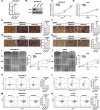RBCK1 is an endogenous inhibitor for triple negative breast cancer via hippo/YAP axis
- PMID: 36280829
- PMCID: PMC9590148
- DOI: 10.1186/s12964-022-00963-8
RBCK1 is an endogenous inhibitor for triple negative breast cancer via hippo/YAP axis
Abstract
Background: Triple negative breast cancer (TNBC) is one of the most lethal breast cancer subtypes. Due to a lack of effective therapeutic targets, chemotherapy is still the main medical treatment for TNBC patients. Thus, it is important and necessary to find new therapeutic targets for TNBC. Recent genomic studies implicated the Hippo / Yap signal is over activated in TNBC, manifesting it plays a key role in TNBC carcinogenesis and cancer progression. RBCK1 was firstly identified as an important component for linear ubiquitin assembly complex (LUBAC) and facilitates NFKB signaling in immune response. Further studies showed RBCK1 also facilitated luminal type breast cancer growth and endocrine resistance via trans-activation estrogen receptor alpha.
Methods: RBCK1 and YAP protein expression levels were measured by western blotting, while the mRNA levels of YAP target genes were measured by RT-PCR. RNA sequencing data were analyzed by Ingenuity Pathway Analysis. Identification of Hippo signaling activity was accomplished with luciferase assays, RT-PCR and western blotting. Protein stability assays and ubiquitin assays were used to detect YAP protein degradation. Ubiquitin-based immunoprecipitation assays were used to detect the specific ubiquitination modification on the YAP protein.
Results: In our current study, our data revealed an opposite function for RBCK1 in TNBC progression. RBCK1 over-expression inhibited TNBC cell progression in vitro and in vivo, while RBCK1 depletion promoted TNBC cell invasion. The whole genomic expression profiling showed that RBCK1 depletion activated Hippo/YAP axis. RBCK1 depletion increased YAP protein level and Hippo target gene expression in TNBC. The molecular biology studies confirmed that RBCK1 could bind to YAP protein and enhance the stability of YAP protein by promoting YAP K48-linked poly-ubiquitination at several YAP lysine sites (K76, K204 and K321).
Conclusion: Our study revealed the multi-faced RBCK1 function in different subtypes of breast cancer patients and a promising therapeutic target for TNBC treatment. Video abstract.
Keywords: Breast cancer; RBCK1; Ubiquitin; YAP.
© 2022. The Author(s).
Conflict of interest statement
All authors claim no conflict of interest.
Figures








Similar articles
-
ZNF213 negatively controls triple negative breast cancer progression via Hippo/YAP signaling.Cancer Sci. 2021 Jul;112(7):2714-2727. doi: 10.1111/cas.14916. Epub 2021 May 3. Cancer Sci. 2021. PMID: 33939216 Free PMC article.
-
RNF31 represses cell progression and immune evasion via YAP/PD-L1 suppression in triple negative breast Cancer.J Exp Clin Cancer Res. 2022 Dec 29;41(1):364. doi: 10.1186/s13046-022-02576-y. J Exp Clin Cancer Res. 2022. PMID: 36581998 Free PMC article.
-
RNF181 modulates Hippo signaling and triple negative breast cancer progression.Cancer Cell Int. 2020 Jul 6;20:291. doi: 10.1186/s12935-020-01397-3. eCollection 2020. Cancer Cell Int. 2020. PMID: 32655323 Free PMC article.
-
[Hydnocarpin inhibits malignant progression of triple negative breast cancer via CNOT4-mediated ubiquitination and degradation of YAP].Zhongguo Zhong Yao Za Zhi. 2023 Aug;48(16):4483-4492. doi: 10.19540/j.cnki.cjcmm.20230510.706. Zhongguo Zhong Yao Za Zhi. 2023. PMID: 37802875 Chinese.
-
Regulation of Hippo signaling and triple negative breast cancer progression by an ubiquitin ligase RNF187.Oncogenesis. 2020 Mar 20;9(3):36. doi: 10.1038/s41389-020-0220-5. Oncogenesis. 2020. PMID: 32198343 Free PMC article.
Cited by
-
RBCK1 overexpression is associated with immune cell infiltration and poor prognosis in hepatocellular carcinoma.Aging (Albany NY). 2024 Jan 11;16(1):538-549. doi: 10.18632/aging.205393. Epub 2024 Jan 11. Aging (Albany NY). 2024. PMID: 38214606 Free PMC article.
-
Posttranslational modifications of YAP/TAZ: molecular mechanisms and therapeutic opportunities.Cell Mol Biol Lett. 2025 Jul 17;30(1):83. doi: 10.1186/s11658-025-00760-4. Cell Mol Biol Lett. 2025. PMID: 40676528 Free PMC article. Review.
-
PANoptosis-related prognostic signature predicts overall survival of cutaneous melanoma and provides insights into immune infiltration landscape.Sci Rep. 2023 May 25;13(1):8449. doi: 10.1038/s41598-023-35462-4. Sci Rep. 2023. PMID: 37231081 Free PMC article.
-
LINC00525 drives aggressive phenotypes in bladder cancer via YAP stabilization-mediated transcriptional activation.Cancer Cell Int. 2025 Jun 17;25(1):214. doi: 10.1186/s12935-025-03851-6. Cancer Cell Int. 2025. PMID: 40528165 Free PMC article.
-
USP12 facilitates gastric cancer progression via stabilizing YAP.Cell Death Discov. 2024 Apr 11;10(1):174. doi: 10.1038/s41420-024-01943-2. Cell Death Discov. 2024. PMID: 38605077 Free PMC article.
References
-
- Chan WL, Marinho J, Chavarri-Guerra Y, Hincapie-Echeverri J, Velasco RN, Jr, Akagunduz B, et al. Systemic treatment for triple negative breast cancer in older patients: A Young International Society of Geriatric Oncology Review Paper. J Geriatr Oncol. 2022;13:563–571. - PubMed
-
- Nagini S. Breast cancer: current molecular therapeutic targets and new players. Anticancer Agents Med Chem. 2017;17:152–163. - PubMed
Publication types
MeSH terms
Substances
LinkOut - more resources
Full Text Sources
Molecular Biology Databases

